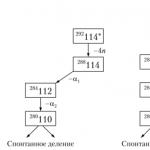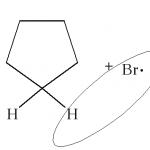Circular movement. Uniform motion in a circle Motion of a point in a circle motion characteristics
Since the linear speed uniformly changes direction, then the movement along the circle cannot be called uniform, it is uniformly accelerated.
Angular velocity
Pick a point on the circle 1 . Let's build a radius. For a unit of time, the point will move to the point 2 . In this case, the radius describes the angle. The angular velocity is numerically equal to the angle of rotation of the radius per unit time.


Period and frequency
Rotation period T is the time it takes the body to make one revolution.
RPM is the number of revolutions per second.


The frequency and period are related by the relation


Relationship with angular velocity


Line speed
Each point on the circle moves at some speed. This speed is called linear. The direction of the linear velocity vector always coincides with the tangent to the circle. For example, sparks from under a grinder move, repeating the direction of instantaneous speed.

Consider a point on a circle that makes one revolution, the time that is spent - this is the period T. The path traveled by a point is the circumference of a circle.


centripetal acceleration
When moving along a circle, the acceleration vector is always perpendicular to the velocity vector, directed to the center of the circle.



Using the previous formulas, we can derive the following relations

Points lying on the same straight line emanating from the center of the circle (for example, these can be points that lie on the wheel spoke) will have the same angular velocities, period and frequency. That is, they will rotate in the same way, but with different linear speeds. The farther the point is from the center, the faster it will move.
The law of addition of velocities is also valid for rotational motion. If the motion of a body or frame of reference is not uniform, then the law applies to instantaneous velocities. For example, the speed of a person walking along the edge of a rotating carousel is equal to the vector sum of the linear speed of rotation of the edge of the carousel and the speed of the person.
The Earth participates in two main rotational movements: daily (around its axis) and orbital (around the Sun). The period of rotation of the Earth around the Sun is 1 year or 365 days. The Earth rotates around its axis from west to east, the period of this rotation is 1 day or 24 hours. Latitude is the angle between the plane of the equator and the direction from the center of the Earth to a point on its surface.
According to Newton's second law, the cause of any acceleration is a force. If a moving body experiences centripetal acceleration, then the nature of the forces that cause this acceleration may be different. For example, if a body moves in a circle on a rope tied to it, then the acting force is the elastic force.

If a body lying on a disk rotates along with the disk around its axis, then such a force is the force of friction. If the force ceases to act, then the body will continue to move in a straight line
Consider the movement of a point on a circle from A to B. The linear velocity is equal to v A And v B respectively. Acceleration is the change in speed per unit of time. Let's find the difference of vectors.
Circular motion is the simplest case of curvilinear motion of a body. When a body moves around a certain point, along with the displacement vector, it is convenient to introduce the angular displacement ∆ φ (the angle of rotation relative to the center of the circle), measured in radians.
Knowing the angular displacement, it is possible to calculate the length of the circular arc (path) that the body has passed.
∆ l = R ∆ φ
If the angle of rotation is small, then ∆ l ≈ ∆ s .
Let's illustrate what has been said:
Angular velocity
With curvilinear motion, the concept of angular velocity ω is introduced, that is, the rate of change in the angle of rotation.
Definition. Angular velocity
The angular velocity at a given point of the trajectory is the limit of the ratio of the angular displacement ∆ φ to the time interval ∆ t during which it occurred. ∆t → 0 .
ω = ∆ φ ∆ t , ∆ t → 0 .
The unit of measure for angular velocity is radians per second (r a d s).
There is a relationship between the angular and linear velocities of the body when moving in a circle. Formula for finding the angular velocity:
With uniform motion in a circle, the speeds v and ω remain unchanged. Only the direction of the linear velocity vector changes.
In this case, a uniform movement along a circle on the body is affected by centripetal, or normal acceleration, directed along the radius of the circle to its center.
a n = ∆ v → ∆ t , ∆ t → 0
The centripetal acceleration module can be calculated by the formula:
a n = v 2 R = ω 2 R
Let us prove these relations.
Let's consider how the vector v → changes over a small period of time ∆ t . ∆ v → = v B → - v A → .
At points A and B, the velocity vector is directed tangentially to the circle, while the velocity modules at both points are the same.
By definition of acceleration:
a → = ∆ v → ∆ t , ∆ t → 0
Let's look at the picture:

Triangles OAB and BCD are similar. It follows from this that O A A B = B C C D .
If the value of the angle ∆ φ is small, the distance A B = ∆ s ≈ v · ∆ t . Taking into account that O A \u003d R and C D \u003d ∆ v for the similar triangles considered above, we get:
R v ∆ t = v ∆ v or ∆ v ∆ t = v 2 R
When ∆ φ → 0 , the direction of the vector ∆ v → = v B → - v A → approaches the direction to the center of the circle. Assuming that ∆ t → 0 , we get:
a → = a n → = ∆ v → ∆ t ; ∆t → 0 ; a n → = v 2 R .
With uniform motion along a circle, the acceleration module remains constant, and the direction of the vector changes with time, while maintaining orientation to the center of the circle. That is why this acceleration is called centripetal: the vector at any time is directed towards the center of the circle.
The record of centripetal acceleration in vector form is as follows:
a n → = - ω 2 R → .
Here R → is the radius vector of a point on a circle with origin at its center.
In the general case, acceleration when moving along a circle consists of two components - normal and tangential.
Consider the case when the body moves along the circle non-uniformly. Let us introduce the concept of tangential (tangential) acceleration. Its direction coincides with the direction of the linear velocity of the body and at each point of the circle is directed tangentially to it.
a τ = ∆ v τ ∆ t ; ∆t → 0
Here ∆ v τ \u003d v 2 - v 1 is the change in the velocity module over the interval ∆ t
The direction of full acceleration is determined by the vector sum of normal and tangential accelerations.

Circular motion in a plane can be described using two coordinates: x and y. At each moment of time, the speed of the body can be decomposed into components v x and v y .
If the motion is uniform, the values v x and v y as well as the corresponding coordinates will change in time according to a harmonic law with a period T = 2 π R v = 2 π ω

If you notice a mistake in the text, please highlight it and press Ctrl+Enter
Circular motion is a special case of curvilinear motion. The speed of the body at any point of the curvilinear trajectory is directed tangentially to it (Fig. 2.1). In this case, the speed as a vector can change both in absolute value (value) and in direction. If the speed module  remains unchanged, then one speaks of uniform curvilinear motion.
remains unchanged, then one speaks of uniform curvilinear motion.
Let the body move in a circle with a constant velocity from point 1 to point 2.

In this case, the body will cover a path equal to the length of the arc ℓ 12 between points 1 and 2 in time t. During the same time t, the radius-vector R drawn from the center of the circle 0 to the point will rotate through the angle Δφ.
The velocity vector at point 2 differs from the velocity vector at point 1 by direction by ΔV:
 ;
;
To characterize the change in the velocity vector by δv, we introduce the acceleration:
 (2.4)
(2.4)
Vector  at any point of the trajectory is directed along the radius Rk center circle perpendicular to the velocity vector V 2 . Therefore, the acceleration
at any point of the trajectory is directed along the radius Rk center circle perpendicular to the velocity vector V 2 . Therefore, the acceleration  , which characterizes the change in speed during curvilinear motion
, which characterizes the change in speed during curvilinear motion  in direction, called centripetal or normal. Thus, the movement of a point along a circle with a constant modulo speed is accelerated.
in direction, called centripetal or normal. Thus, the movement of a point along a circle with a constant modulo speed is accelerated.
If the speed  changes not only in direction, but also in absolute value (value), then in addition to normal acceleration
changes not only in direction, but also in absolute value (value), then in addition to normal acceleration  also introduce tangent (tangential) acceleration
also introduce tangent (tangential) acceleration  , which characterizes the change in speed in magnitude:
, which characterizes the change in speed in magnitude:
 or
or 
Directed vector  tangentially at any point of the trajectory (i.e. coincides with the direction of the vector
tangentially at any point of the trajectory (i.e. coincides with the direction of the vector  ). Angle between vectors
). Angle between vectors  And
And  is equal to 90 0 .
is equal to 90 0 .
The total acceleration of a point moving along a curved path is defined as a vector sum (Fig. 2.1.).
 .
.
Vector modulus  .
.
Angular Velocity and Angular Acceleration
When moving a material point around the circumference the radius-vector R, drawn from the center of the circle O to the point, rotates through the angle Δφ (Fig. 2.1). To characterize rotation, the concepts of angular velocity ω and angular acceleration ε are introduced.
The angle φ can be measured in radians. 1 rad is equal to the angle that rests on the arc ℓ equal to the radius R of the circle, i.e.
 or ℓ
12
=
Rφ
(2.5.)
or ℓ
12
=
Rφ
(2.5.)
We differentiate equation (2.5.)
 (2.6.)
(2.6.)
Value dℓ/dt=V inst. The value ω \u003d dφ / dt is called angular velocity(measured in rad/s). We get the relationship between linear and angular velocities:
The quantity ω is vector. vector direction  determined screw (gimlet) rule: it coincides with the direction of movement of the screw, oriented along the axis of rotation of the point or body and rotated in the direction of rotation of the body (Fig. 2.2), i.e.
determined screw (gimlet) rule: it coincides with the direction of movement of the screw, oriented along the axis of rotation of the point or body and rotated in the direction of rotation of the body (Fig. 2.2), i.e.  .
.
angular acceleration called the vector quantity derivative of the angular velocity (instantaneous angular acceleration)
called the vector quantity derivative of the angular velocity (instantaneous angular acceleration)
 ,
(2.8.)
,
(2.8.)
Vector  coincides with the axis of rotation and is directed in the same direction as the vector
coincides with the axis of rotation and is directed in the same direction as the vector  , if the rotation is accelerated, and in the opposite direction, if the rotation is slow.
, if the rotation is accelerated, and in the opposite direction, if the rotation is slow.
Speednbody per unit time is calledspeed .
The time T of one complete rotation of the body is calledrotation period . WhereinRdescribes the angle Δφ=2π radians
With that said
 ,
(2.9)
,
(2.9)
Equation (2.8) can be written as follows:
 (2.10)
(2.10)
Then the tangential component of the acceleration
and =R(2.11)
Normal acceleration a n can be expressed as follows:

in view of (2.7) and (2.9)
 (2.12)
(2.12)
Then the full acceleration
For rotational motion with constant angular acceleration , the kinematics equation can be written by analogy with equation (2.1) - (2.3) for translational motion:
 ,
,
 .
.




